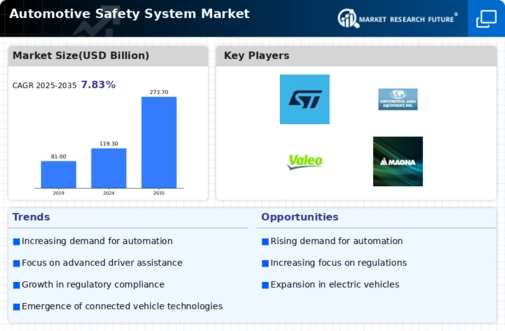Automotive Safety System Market Summary
As per Market Research Future Analysis, the Automotive Safety System market was valued at USD 119.35 Billion in 2024 and is projected to reach USD 273.56 Billion by 2035, growing at a CAGR of 7.83% from 2025 to 2035. Key drivers include the increasing demand for safe driving experiences and luxury vehicles. Technological advancements, such as Volvo's Active Grip Control and Denso's advanced driver-supporting technology, are enhancing safety features in vehicles. The market is segmented by fuel type, active technology, offering, passive technology, and vehicle type, with hydraulic processes and TPMS leading in revenue generation. North America dominates the market, followed by Europe and Asia-Pacific, with significant growth expected in the latter due to high automobile production.
Key Market Trends & Highlights
The Automotive Safety System market is witnessing significant growth driven by technological advancements and increasing safety awareness.
- Market Size in 2024: USD 119.35 Billion; projected to reach USD 273.56 Billion by 2035.
- CAGR from 2025 to 2035: 7.83%; driven by demand for advanced safety features.
- Hydraulic process segment accounts for 35% of market revenue; fastest growth in mechanical processes.
- TPMS generated the most income at 70.4%; EBD is the fastest-growing category due to regulatory mandates.
Market Size & Forecast
| 2024 Market Size | USD 119.35 Billion |
| 2035 Market Size | USD 273.56 Billion |
| CAGR | 7.83% |
Major Players
Key players include Robert Bosch GmbH, DENSO CORPORATION, Continental AG, ZF Friedrichshafen, Autoliv Inc., Hyundai Mobis, Valeo, and Magna International.
















Leave a Comment